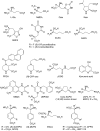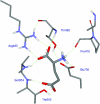The glutamate story
- PMID: 16402093
- PMCID: PMC1760733
- DOI: 10.1038/sj.bjp.0706444
The glutamate story
Abstract
Glutamatergic synaptic transmission in the mammalian central nervous system was slowly established over a period of some 20 years, dating from the 1950s. Realisation that glutamate and like amino acids (collectively known as excitatory amino acids (EAA)) mediated their excitatory actions via multiple receptors preceded establishment of these receptors as synaptic transmitter receptors. EAA receptors were initially classified as N-methyl-D-aspartate (NMDA) and non-NMDA receptors, the latter subdivided into quisqualate (later AMPA) and kainate receptors after agonists that appeared to activate these receptors preferentially, and by their sensitivity to a range of differentially acting antagonists developed progressively during the 1970s. NMDA receptors were definitively shown to be synaptic receptors on spinal neurones by the sensitivity of certain excitatory pathways in the spinal cord to a range of specific NMDA receptor antagonists. Importantly, specific NMDA receptor antagonists appeared to be less effective at synapses in higher centres. In contrast, antagonists that also blocked non-NMDA as well as NMDA receptors were almost universally effective at blocking synaptic excitation within the brain and spinal cord, establishing both the existence and ubiquity of non-NMDA synaptic receptor systems throughout the CNS. In the early 1980s, NMDA receptors were shown to be involved in several central synaptic pathways, acting in concert with non-NMDA receptors under conditions where a protracted excitatory postsynaptic potential was effected in response to intense stimulation of presynaptic fibres. Such activation of NMDA receptors together with non-NMDA receptors led to the phenomenon of long-term potentiation (LTP), associated with lasting changes in synaptic efficacy (synaptic plasticity) and considered to be an important process in memory and learning. During the 1980s, it was shown that certain glutamate receptors in the brain mediated biochemical changes that were not susceptible to NMDA or non-NMDA receptor antagonists. This dichotomy was resolved in the early 1990s by the techniques of molecular biology, which identified two families of glutamate-binding receptor proteins (ionotropic (iGlu) and metabotropic (mGlu) receptors). Development of antagonists binding to specific protein subunits is currently enabling precise identification of discrete iGlu or mGlu receptor subtypes that participate in a range of central synaptic processes, including synaptic plasticity.
Figures




Similar articles
-
[Role of excitatory amino acids in neuropathology].Medicina (B Aires). 1995;55(4):355-65. Medicina (B Aires). 1995. PMID: 8728878 Review. Spanish.
-
The history of the pharmacology and cloning of ionotropic glutamate receptors and the development of idiosyncratic nomenclature.Neuropharmacology. 2009 Jan;56(1):6-21. doi: 10.1016/j.neuropharm.2008.08.006. Epub 2008 Aug 14. Neuropharmacology. 2009. PMID: 18765242 Review.
-
Glutamate is the transmitter for N2v retraction phase interneurons of the Lymnaea feeding system.J Neurophysiol. 1997 Dec;78(6):3408-14. doi: 10.1152/jn.1997.78.6.3408. J Neurophysiol. 1997. PMID: 9405554
-
Selective antagonism of amino acid-induced and synaptic excitation in the cat spinal cord.J Physiol. 1979 Dec;297(0):621-35. doi: 10.1113/jphysiol.1979.sp013060. J Physiol. 1979. PMID: 536925 Free PMC article.
-
Enflurane directly depresses glutamate AMPA and NMDA currents in mouse spinal cord motor neurons independent of actions on GABAA or glycine receptors.Anesthesiology. 2000 Oct;93(4):1075-84. doi: 10.1097/00000542-200010000-00032. Anesthesiology. 2000. PMID: 11020764
Cited by
-
The Redox Biology of Excitotoxic Processes: The NMDA Receptor, TOPA Quinone, and the Oxidative Liberation of Intracellular Zinc.Front Neurosci. 2020 Jul 24;14:778. doi: 10.3389/fnins.2020.00778. eCollection 2020. Front Neurosci. 2020. PMID: 32792905 Free PMC article. Review.
-
The biology of memory: a forty-year perspective.J Neurosci. 2009 Oct 14;29(41):12748-56. doi: 10.1523/JNEUROSCI.3958-09.2009. J Neurosci. 2009. PMID: 19828785 Free PMC article.
-
Phosphorylation Induces Conformational Rigidity at the C-Terminal Domain of AMPA Receptors.J Phys Chem B. 2019 Jan 10;123(1):130-137. doi: 10.1021/acs.jpcb.8b10749. Epub 2018 Dec 27. J Phys Chem B. 2019. PMID: 30537817 Free PMC article.
-
N-methyl-D-aspartate receptors mediate the phosphorylation and desensitization of muscarinic receptors in cerebellar granule neurons.J Biol Chem. 2009 Jun 19;284(25):17147-17156. doi: 10.1074/jbc.M901031200. Epub 2009 Mar 30. J Biol Chem. 2009. PMID: 19332541 Free PMC article.
-
Neuroprotective effects of Asiaticoside.Neural Regen Res. 2014 Jul 1;9(13):1275-82. doi: 10.4103/1673-5374.137574. Neural Regen Res. 2014. PMID: 25221579 Free PMC article.
References
-
- BISCOE T.J., EVANS R.H., FRANCIS A.A., MARTIN M.R., WATKINS J.C., DAVIES J., DRAY A. D-α-aminoadipateas a selective antagonist of amino acid-induced and synaptic excitation of mammalian spinal neurones. Nature (London) 1977;270:743–745. - PubMed
-
- BORTOLOTTO Z.A., BASHIR Z.I., DAVIES C.H., COLLINGRIDGE G.L. A molecular switch activated by metabotropic glutamate receptors regulates induction of long-term potentiation. Nature. 1994;368:740–743. - PubMed
-
- BORTOLOTTO Z.A., CLARKE V.R.J., DELANY C.M., PARRY M.C., SMOLDERS I., VIGNES M., HOO K.H., BRINTON B., FANTASKE R., OGDEN A., GATES M., ORNSTEIN P.L., LODGE D., BLEAKMAN D., COLLINGRIDGE G.L. Kainate receptors are involved in synaptic plasticity. Nature. 1999;402:297–301. - PubMed
-
- COLLINGRIDGE G.L., ISAAC J.T., WANG Y.T. Receptor trafficking and synaptic plasticity. Nat. Rev. Neurosci. 2004;5:952–962. - PubMed
Publication types
MeSH terms
Substances
Grants and funding
LinkOut - more resources
Full Text Sources
Other Literature Sources

